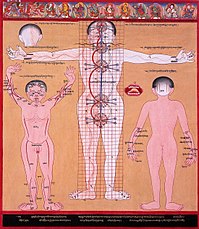Trul khor
| Trul khor | |||||
| Tibetan name | |||||
|---|---|---|---|---|---|
| Tibetan | རྩ་རླུང་འཁྲུལ་འཁོར་ | ||||
| Literal meaning | magical movement instrument, channels and inner breath currents | ||||
| |||||

Trul khor ('magical instrument' or 'magic circle;' Skt. adhisāra[1]), in full tsa lung trul khor (Sanskrit: vayv-adhisāra 'magical movement instrument, channels and inner breath currents'), also known as yantra yoga, is a Vajrayana discipline which includes pranayama (breath control) and body postures (asanas). From the perspective of the Indo-Tibetan Buddhist traditions of Dzogchen, the mind is merely vāyu (breath or, more literally, wind) in the body. Thus working with vāyu and the body is paramount, while meditation, on the other hand, is considered contrived and conceptual.
Namkhai Norbu Rinpoche (1938-2018), a proponent of trul khor, preferred to use the equivalent Sanskrit-derived English term 'yantra yoga' when writing in English. Trul khor derives from the instructions of the Indian mahasiddhas (great sages) who founded Vajrayana (3rd to 13th centuries CE).
Trul khor traditionally consists of 108 movements, including bodily movements (or dynamic asanas), incantations (or mantras), pranayama and visualizations.[citation needed]
The walls of the Dalai Lama's summer temple of Lukhang depict trul khor asanas.
Lung
Lung (Tibetan: རླུང rlung) means wind or breath. It is a key concept in the Vajrayana traditions of Tibetan Buddhism and has a variety of meanings. Lung is a concept that is particularly important to understandings of the illusory body and the trikaya (body, speech and mind).[2] The 'illusory body', which is often referred to as the 'vajra body' in medieval Tibetan Buddhist discourse, is constituted by the flow of subtle energy currents:
- 'rlung' (Wylie) is equivalent to Sanskrit: prāna or vāyu.
- 'rtsa' (Wylie) is equivalent to Sanskrit: nāḍī, sirā, srota and dhamanī;
Channels
The channels are the energy pathways along which the prana flows. There are three main channels or nadis: ida, pingala, and sushumna.
Yantra yoga
Namkhai Norbu was the first to discuss trul khor in his book on yantra yoga,[3] essentially a commentary on a practical yoga manual by Vairotsana. Namkhai Norbu began dissemination of Yantra Yoga through his practical teaching and esoteric transmission of this discipline within the International Dzogchen Community, which he founded some time after 1975 in Italy, Merigar.
Chaoul (2006) has begun discussion of Bon traditions of Trul Khor in English with his thesis from Rice University.[4] In his work, Chaoul makes reference to a commentary by the famed Bonpo Dzogchen master, Shardza Tashi Gyaltsen.
Tenzin Wangyal Rinpoche's text Awakening the Sacred Body presents some of the basic practices of trul khor according to the Tibetan Bön tradition.[5]
Primary texts
- Tibetan: འཕྲུལ་འཁོར་ཉི་ཟླ་ཁ་སྦྱོར་གྱི་དགོངས་འགྲེལ་དྲི་མེད་ནོར་བུའི་མེ་ལོང, Wylie: 'phrul 'khor nyi zla kha sbyor gyi dgongs 'grel dri med nor bu'i me long
- Shardza Tashi Gyaltsen: byang zab nam mkha' mdzod chen las snyan rgyud rtsa rlung 'phrul 'khor
See also
References
Citations
- ^
Wallace, Karma Chagmé ; with commentary by Gyatrul Rinpoche ; translated by B. Alan (1998). A spacious path to freedom : practical instructions on the union of Mahāmudrā and Atiyoga. Ithaca, N.Y.: Snow Lion Publications. p. 69. ISBN 1559390719.
{{cite book}}: CS1 maint: multiple names: authors list (link) - ^ Arya, Pasang Yonten (2009). Tibetan Tantric Yoga (accessed: January 8, 2013)
- ^ Norbu, Namkhai; Andrico, Fabio (2013). Tibetan yoga of movement : the art and practice of yantra yoga. Berkeley, California: North Atlantic Books. ISBN 978-1583945568.
- ^ Chaoul, Alejandro (2006). Magical movements ('phrul 'khor): ancient yogic practices in the Bon religion and contemporary medical perspectives (Thesis). Rice University. p. 52. hdl:1911/18880. Retrieved 7 March 2011.
- ^ Tenzin Wangyal Rinpoche 2011.
Works cited
- Chaoul-Reich, Alejandro. Spinning the Magical Wheel in The Snow Lion Newsletter. Snow Lion Publications. Retrieved 1 December 2006.
- Chaoul-Reich, Alejandro. Tibetan Yoga from the Bon Tradition in Snow Lion Magazine. Snow Lion Publications.
- Lipson, Elaine. Into the Mystic in Yoga Journal.
- Norbu, Chögyal Namkhai (2000). Revision: Laura Evangelisti. Translation: Des Barry, Nina Robinson, Liz Granger, Carol Chaney. Yantra Yoga Manual. Italy, Shang Shung Edizioni. (This booklet is published for those who have received the transmission of these practices from Chögyal Namkhai Norbu Rinpoche.)
- Yogic practices in the Bon tradition by M Alejandro Chaoul
- Ancient drawing from the Blue Beryl by Sangye Gyamtso (1653-1705)
- Lipman, Kennard (1987).'The Dynamic Yoga of Tibet: combining asanas, breathing exercises, and flowing movements, Yantra Yoga aims to return us to our "natural state".' Cited in: Yoga Journal, May 1987, No. 74. Active Interest Media. ISSN 0191-0965. Source: [1] (accessed: Friday April 9, 2010) p. 46-49
- Tenzin Wangyal Rinpoche (2011). Awakening the Sacred Body. Hay House. ISBN 978-1-4019-2871-1.
Further reading
- Chang, Garma C. C. (1993). Teachings of Tibetan Yoga: An Introduction to the Spiritual, Mental, and Physical Exercises of the Tibetan Religion. Kensington Pub Corp. ISBN 978-0-8065-1453-6.
- Chaoul, M. Alejandro (2003). "Yogic practices (rtsarlung 'phr ul 'khor) in the Bon tradition and possible applications as a CIM (complementary and integrative medicine) therapy". International Association for Tibetan Studies. Archived from the original on 2007-12-13. Retrieved 2008-02-03.
{{cite web}}: CS1 maint: bot: original URL status unknown (link) - Norbu, Namkhai (2017). Yantra Yoga: Tibetan Yoga of Movement. Translated by Adriano Clemente. Snow Lion Publications. ISBN 978-1559398978.
